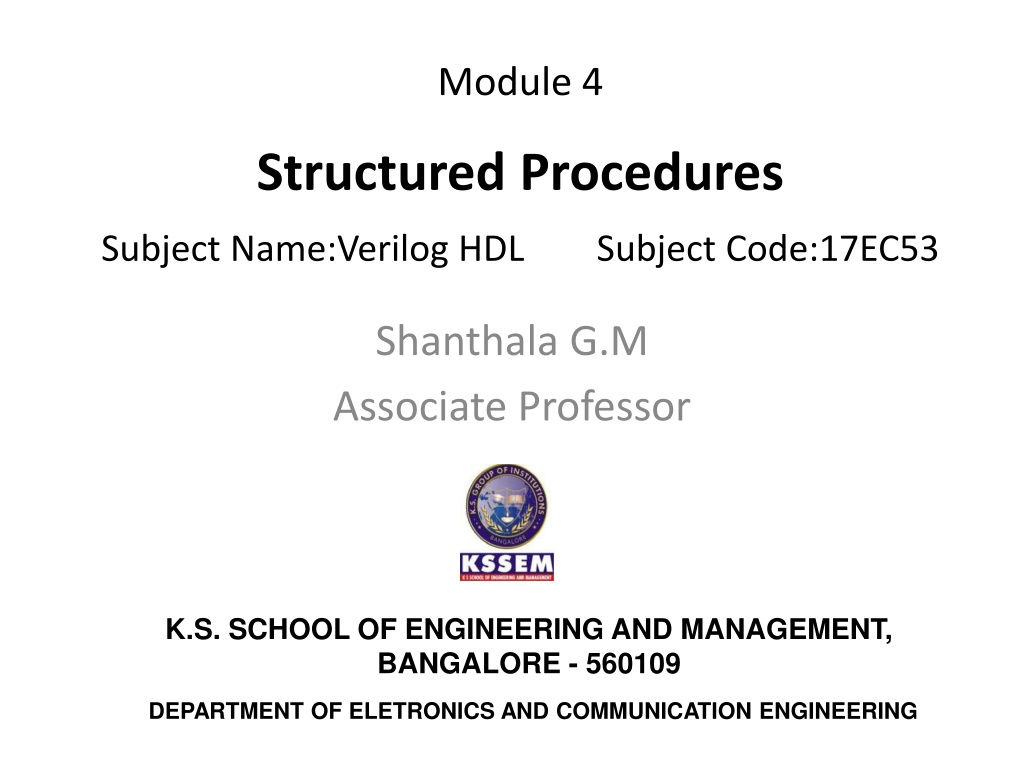
Verilog HDL Structured Procedures and Examples
Explore structured procedures in Verilog HDL, including initial and always statements. Learn how to declare and initialize ports, model continuous activity with always statements, and create clock generation modules. Dive into examples and detailed explanations for better understanding.
Download Presentation

Please find below an Image/Link to download the presentation.
The content on the website is provided AS IS for your information and personal use only. It may not be sold, licensed, or shared on other websites without obtaining consent from the author. If you encounter any issues during the download, it is possible that the publisher has removed the file from their server.
You are allowed to download the files provided on this website for personal or commercial use, subject to the condition that they are used lawfully. All files are the property of their respective owners.
The content on the website is provided AS IS for your information and personal use only. It may not be sold, licensed, or shared on other websites without obtaining consent from the author.
E N D
Presentation Transcript
Module 4 Structured Procedures Subject Name:Verilog HDL Subject Code:17EC53 Shanthala G.M Associate Professor K.S. SCHOOL OF ENGINEERING AND MANAGEMENT, BANGALORE - 560109 DEPARTMENT OF ELETRONICS AND COMMUNICATION ENGINEERING
Structured Procedures There are two structured procedure statements in Verilog: 1)always and 2)initial statements
Example 7-1 initial Statement module stimulus; reg x,y, a,b, m; initial m = 1'b0; //single statement; does not need to be grouped initial begin #5 a = 1'b1; //multiple statements; need to be grouped #25 b = 1'b0; end initial begin #10 x = 1'b0; #25 y = 1'b1; end initial 128 #50 $finish; endmodule
result 0 m = 1'b0; 5 a = 1'b1; 10 x = 1'b0; 30 b = 1'b0; 35 y = 1'b1; 50 $finish;
Combined Port/Data Declaration and Initialization module adder (sum, co, a, b, ci); output reg [7:0] sum = 0; //Initialize 8 bit output sum output reg co = 0; //Initialize 1 bit output co input [7:0] a, b; input ci; -- -- endmodule
Combined ANSI C Style Port Declaration and Initialization ANSI C style port declaration can also be combined with an initialization. Example -Combined ANSI C Port Declaration and Variable Initialization module adder (output reg [7:0] sum = 0, //Initialize 8 bit output output reg co = 0, //Initialize 1 bit output co input [7:0] a, b, input ci ); -- -- endmodule
always Statement All behavioral statements inside an always statement constitute an always block. The always statement starts at time 0 and executes the statements in the always block continuously in a looping fashion. This statement is used to model a block of activity that is repeated continuously in a digital circuit. An example is a clock generator module that toggles the clock signal every half cycle.
Clock generation module clock_gen (output reg clock); initial clock = 1'b0; always #10 clock = ~clock; Initial #1000 $finish; endmodule
Procedural Assignments Procedural assignments update values of reg, integer, real, or time variables. The value placed on a variable will remain unchanged until another procedural assignment updates the variable with a different value
assignment ::= variable_lvalue = [ delay_or_event_control ] expression The left-hand side of a procedural assignment <lvalue> can be one of the following: A reg, integer, real, or time register variable or a memory element A bit select of these variables (e.g., addr[0]) A part select of these variables (e.g., addr[31:16]) A concatenation of any of the above
Two types of procedural assignment statements:. Blocking and Nonblocking Blocking assignment statements are executed in the order they are specified in a sequential block. A blocking assignment will not block execution of statements that follow in a parallel block. The = operator is used to specify blocking assignments.
reg x, y, z; reg [15:0] reg_a, reg_b; integer count; initial begin x = 0; y = 1; z = 1; //Scalar assignments count = 0; //Assignment to integer variables reg_a = 16'b0; reg_b = reg_a; //initialize vectors #15 reg_a[2] = 1'b1; //Bit select assignment with delay #10 reg_b[15:13] = {x, y, z} //Assign result of concatenation to // part select of a vector count = count + 1; //Assignment to an integer (increment) end
Nonblocking Assignment Example reg x, y, z; reg [15:0] reg_a, reg_b; integer count; initial begin x = 0; y = 1; z = 1; //Scalar assignments count = 0; //Assignment to integer variables reg_a = 16'b0; reg_b = reg_a; //Initialize vectors reg_a[2] <= #15 1'b1; //Bit select assignment with delay reg_b[15:13] <= #10 {x, y, z}; //Assign result of concatenation count <= count + 1; //Assignment to an integer (increment) end
Nonblocking assignments allow scheduling of assignments without blocking execution of the statements that follow in a sequential block. A <= operator is used to specify nonblocking assignments. Note that this operator has the same symbol as a relational operator, less_than_equal_to. The operator <= is interpreted as a relational operator in an expression and as an assignment operator in the context of a nonblocking assignment.
1. reg_a[2] = 0 is scheduled to execute after 15 units (i.e., time = 15) 2. reg_b[15:13] = {x, y, z} is scheduled to execute after 10 time units (i.e., time = 10) 3. count = count + 1 is scheduled to be executed without any delay (i.e., time = 0)
Application of nonblocking assignments always @(posedge clock) begin reg1 <= #1 in1; reg2 <= @(negedge clock) in2 ^ in3; reg3 <= #1 reg1; //The old value of reg1 end
At each positive edge of clock, the following sequence takes place for the nonblocking assignments. A read operation is performed on each right-hand-side variable, in1, in2, in3, and reg1, at the positive edge of clock. The write operations to the left-hand-side variables are scheduled to be executed at the time specified by the intra- assignment delay in each assignment. The write operations are executed at the scheduled time steps. The order in which the write operations are executed is not important because the internally stored right-hand-side expression values are used to assign to the left-hand-side values..
Web Links https://www.youtube.com/watch?v=FWE0-FOoE4s Video link from altera on verilog HDL basics https://ocw.mit.edu/courses/electrical-engineering- and-computer-science/6-884-complex-digital- systems-spring-2005/lecture-notes/l02_verilog.pdf Power point presentation from MIT. https://www.youtube.com/watch?v=PJGvZSlsLKs NPTEL Video from Prof Indranil Senguptha, IIT Kharagpur on Introduction to Hardware Modeling using verilog


















